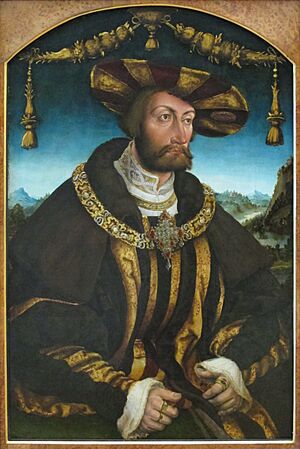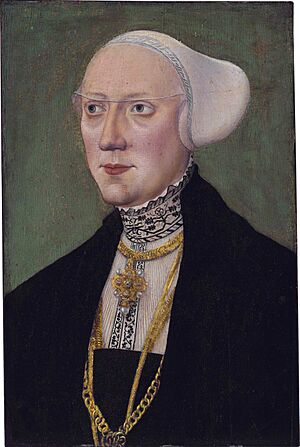William IV, Duke of Bavaria facts for kids
Quick facts for kids William IV |
|
|---|---|

Portrait by Hans Wertinger
|
|
| Duke of Bavaria | |
| Reign | 18 March 1508 – 7 March 1550 |
| Predecessor | Albert IV |
| Successor | Albert V |
| Co-ruler | Louis X (1516–1545) |
| Born | 13 November 1493 Munich |
| Died | 7 March 1550 (aged 56) Munich |
| Burial | Munich Frauenkirche |
| Spouse | Jakobaea of Baden |
| Issue | Albert V, Duke of Bavaria Mechthild of Bavaria |
| House | House of Wittelsbach |
| Father | Albert IV, Duke of Bavaria |
| Mother | Kunigunde of Austria |
| Religion | Roman Catholicism |
William IV (German: Wilhelm IV) was born on November 13, 1493. He became the Duke of Bavaria in 1508 and ruled until 1550. For a big part of his rule, until 1545, he shared power with his younger brother, Louis X, Duke of Bavaria.
William was born in Munich. His parents were Albert IV and Kunigunde of Austria. Kunigunde was the daughter of Emperor Frederick III.
Contents
William's Rule and Politics
William's father, Albert IV, had made a rule in 1506. This rule said that the oldest son would always become the next duke. But William's younger brother, Louis X, didn't want to become a priest. He argued that he was born before this new rule started.
With help from his mother and important leaders, Louis convinced William to let him rule together. So, in 1516, Louis became a co-ruler. Louis then governed the areas of Landshut and Straubing. They usually worked well together.
Dealing with New Ideas
At first, William was interested in the Reformation. This was a big religious movement started by Martin Luther. But as the Reformation became more popular in Bavaria, William changed his mind.
In 1522, William made a rule in Bavaria. It stopped people from spreading Luther's ideas. In 1524, he made an agreement with Pope Clement VII. After this, William became a main leader in Germany for the Counter-Reformation. This was a movement to strengthen the Catholic Church.
William and Louis X also worked together to stop a big uprising. This was the peasant uprising in Southern Germany in 1525. They joined forces with the archbishop of Salzburg to do this.
Working with Other Rulers
William had some disagreements with the Habsburg family, who were powerful rulers. This was because his brother Louis X wanted to be the king of Bohemia.
The conflict with the Habsburgs ended in 1534. William and Louis made an agreement with Ferdinand I in Linz. Later, William supported Charles V in a war in 1546. This war was against the Schmalkaldic League, a group of Protestant rulers. William's main advisor for 35 years was a strong leader named Leonhard von Eck.
Cultural Achievements
William IV was also known for his contributions to culture and art.
The Bavarian Beer Law
On April 23, 1516, William made a very famous rule in Ingolstadt. This rule was about how Bavarian Beer should be made. It said that only barley, hops, and water could be used. This rule is known as the Reinheitsgebot, or "purity regulation."
This important rule stayed in effect for a very long time. It was only changed in 1986 because of new rules from the European Union.
Art and Music
William was a big supporter of art. In 1523, he hired Ludwig Senfl, a famous musician. This helped the Bavarian State Orchestra become very important.
William also asked Johann Eck to write a special Bible translation in 1537. This Bible, called the Eckbibel, was written to go against Luther's ideas. It was also important because it was written in the Bavarian Upper German language, not the East German Saxon.
William loved collecting art and asked many artists to create works for him. One famous painting he ordered was Battle of Issus by Albrecht Altdorfer. Most of William's art collection is now in the Alte Pinakothek museum in Munich.
Building and Palaces
William also started important building projects. He ordered the expansion of the Neuveste castle in Munich. This led to the creation of the first Court Garden, which was the start of the Munich Residenz palace.
In 1546, William and his son Albert V ordered the building of Dachau Palace. They changed an old Gothic ruin into a beautiful Renaissance style palace. This palace later became a favorite home for the rulers of Bavaria.
William IV passed away in Munich in 1550. His son Albert became the next duke. William is buried in the Munich Frauenkirche in Munich.
Family Life
In 1522, William married Jakobaea of Baden (1507–1580). She was the daughter of Margrave Philip I of Baden. William and Jakobaea had four children:
- Theodor of Bavaria (born 1526 – died 1534)
- Duke Albert V of Bavaria (1528–1579)
- Wilhelm of Bavaria (born 1529 – died 1530)
- Mechthild of Bavaria (born 1532 – died 1565), who married Philibert of Baden in 1557.



